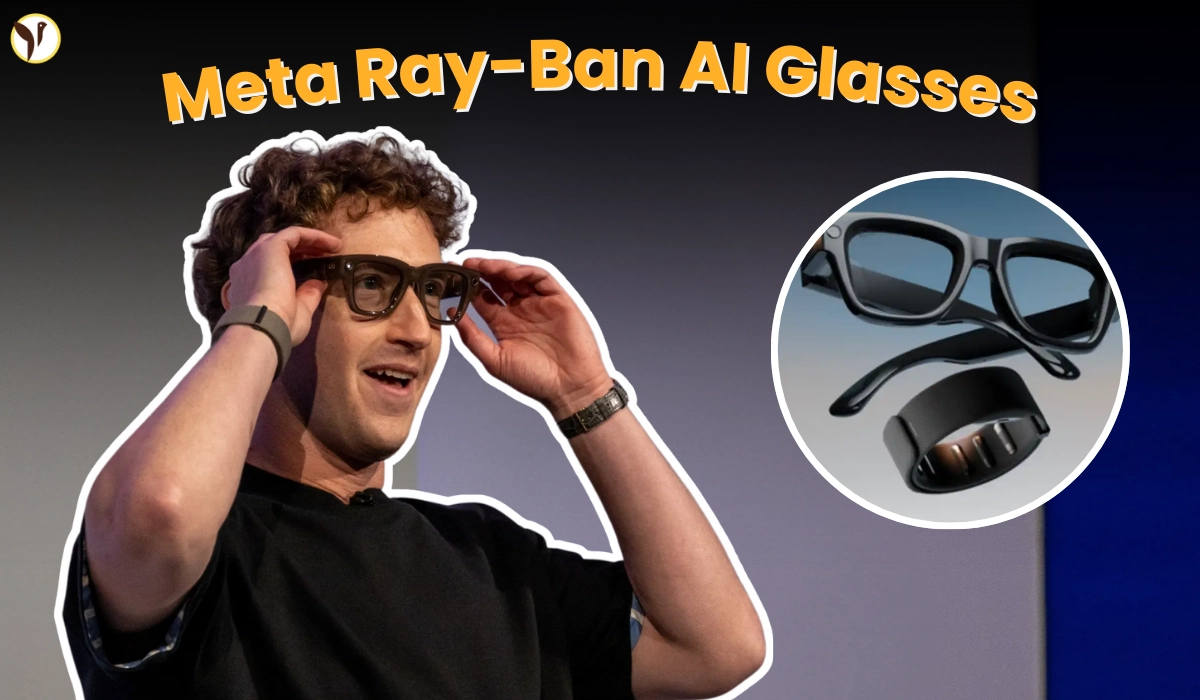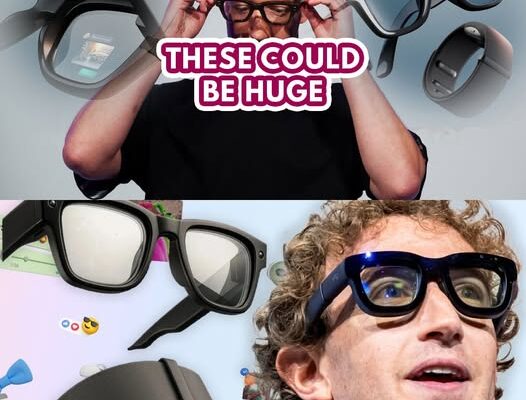A Stage, a Glitch, and a Warning
At Meta Connect 2025, the spotlight was on Mark Zuckerberg—but so was the pressure. The billionaire CEO strode onto the stage wearing what looked like a sleek pair of Ray-Ban sunglasses. Yet these weren’t ordinary shades. They were Meta’s most ambitious gamble yet: the Ray-Ban Display glasses.
Outfitted with a micro-display, built-in cameras, high-fidelity audio, and a neural wristband capable of reading electrical signals from the wearer’s muscles, the glasses were positioned as nothing less than the future of personal computing.
“This isn’t about gadgets,” Zuckerberg told the audience. “This is about augmenting the human mind. Glasses are the only form factor that can let AI see what you see, hear what you hear, and help you in real time.”
Then came the line that sent shockwaves far beyond the tech world:
“In the future, those who don’t adopt this technology may face a cognitive disadvantage.”
The words landed like a thunderclap. Was this vision, or was it intimidation?
What the Glasses Can Do
Meta’s Ray-Ban Display isn’t a full augmented reality headset, but it’s more than smart glasses. The design is deceptively simple, yet packed with next-gen features:
-
Micro-Display in the Lens: A full-color, single-eye HUD (heads-up display) that shows notifications, navigation prompts, translations, or contextual info. It’s visible only to the wearer.
-
Cameras & Audio: High-resolution lenses, open-ear speakers, and beamforming mics allow video calls, voice AI assistants, and instant sharing.
-
Meta Neural Band: A wristband using EMG sensors to read subtle muscle signals in your wrist and fingers. Pinch, swipe, rotate—your hand movements become commands. Future updates will even allow writing words in the air with finger gestures.
-
AI Integration: The glasses sync with Meta’s AI assistant, Grok, for real-time translation, productivity help, and “seeing what you see” contextual responses.
-
Everyday Utility: Call friends on WhatsApp, share your POV on Instagram, translate menus abroad, or get turn-by-turn directions without looking down at a phone.
-
Battery Life: About six hours of mixed use for the glasses; 18 hours for the Neural Band.
The glasses will cost $799 and hit U.S. shelves on September 30, 2025—with an international rollout early next year.
The Demo — and the Glitch
But even the future isn’t immune to Wi-Fi.
During the live demo, Zuckerberg experienced a brief failure when attempting to showcase the real-time translation feature. The Wi-Fi dropped, leaving the audience staring at a frozen screen. Critics pounced, comparing the moment to Steve Jobs’ famous iPhone demo hiccup.
“Maybe the future runs better on 5G,” one journalist quipped on Twitter.
Still, after a quick reset, the glasses functioned smoothly, translating a live Spanish conversation into English subtitles projected in Zuckerberg’s lens. The crowd erupted in applause, forgiving the stumble.
A Bold Claim — or a Threat?
What truly dominated the headlines wasn’t the specs, the demo, or even the $799 price tag. It was Zuckerberg’s warning that non-users could be left cognitively behind.
Tech evangelists praised the bluntness: finally, a CEO admitting that wearable AI isn’t just a tool—it’s an advantage that could widen the gap between haves and have-nots.
Skeptics, however, blasted the rhetoric as dystopian. “This isn’t empowerment—it’s coercion,” wrote one columnist. “It implies that to keep up at work, in school, or in society, you’ll have to strap Meta hardware to your face.”
Privacy advocates raised alarms too. With cameras, microphones, and AI “seeing what you see,” critics warn that the glasses could normalize surveillance in public and private spaces.
Why Glasses, Not Phones?

Zuckerberg argued that the smartphone—once humanity’s central computing device—is nearing obsolescence. Phones keep us heads-down. Glasses, he says, keep us heads-up.
“Your AI shouldn’t live in a box you pull out of your pocket,” he said. “It should be with you, seamlessly integrated into your world.”
By positioning glasses as the ideal platform for AI, Meta is signaling a long game: these devices are not companions to smartphones, but eventual replacements.
The Identity of Meta

The Ray-Ban Display also represents a shift in how Meta wants the world to see it. No longer just the Facebook company, not just a social network, but a hardware + AI pioneer betting its future on immersive computing.
Meta’s massive investment into AR/VR (remember Horizon Worlds?) faced skepticism and even ridicule. But by pivoting into stylish, mainstream wearable tech—partnering with Ray-Ban and Oakley—they’re betting on adoption through fashion as much as through function.
In short: if you’ll wear sunglasses, you’ll wear smart glasses.
The Oakley Surprise
Alongside the Ray-Ban Display, Meta also launched the Oakley Meta Vanguard, a $499 sport-oriented smart glasses model. While it lacks the micro-display, it doubles down on cameras, audio, and fitness integration.
This two-pronged strategy—premium display glasses for early adopters, lifestyle glasses for athletes—shows Meta isn’t aiming for niche hobbyists. They want ubiquity.
Reactions Around the Industry
Competitors are watching closely.
-
Apple, rumored to be working on a lightweight AR device to follow its Vision Pro, now faces pressure to accelerate development.
-
Google, burned by the original Glass, may be preparing a comeback in the wearables race.
-
Snap, once a pioneer with Spectacles, has been quiet—but Meta’s move could reignite its ambitions.
“Meta just lit the match,” one analyst said. “The wearable AI arms race starts now.”
Risks and Challenges
Yet the road ahead is littered with challenges:
-
Privacy Concerns: Recording and streaming what you see raises legal and ethical issues in workplaces, classrooms, and public spaces.
-
Adoption Costs: At $799, plus the stigma of wearing visible tech on your face, mass adoption isn’t guaranteed.
-
Battery & Comfort: Six hours of use won’t last a full day for heavy users. Will consumers accept charging glasses like a phone?
-
Trust in Meta: After years of controversies, will people trust Zuckerberg’s company to literally sit on their face all day?
Beyond Tech — A Cultural Question
At its core, the Ray-Ban Display launch isn’t just about hardware. It’s about what kind of world we want to live in.
Zuckerberg envisions a society where AI glasses become as common as smartphones—where speaking a foreign language, navigating an unfamiliar city, or collaborating on a project all happen seamlessly through your lens.
But it also raises a darker vision: a future where those without such devices are disadvantaged—socially, economically, even cognitively.
“This is the most honest pitch I’ve ever seen from a tech CEO,” one analyst said. “And that’s what makes it terrifying.”
What Happens Next
Meta has announced that U.S. buyers can pre-order starting now, with deliveries set for September 30. International launches are expected in early 2026, beginning with Europe and Canada.
Meta is also offering early developer kits, encouraging app makers to build tools that leverage the glasses’ display and neural inputs. Translation, live coaching, gaming overlays, health metrics—the ecosystem is expected to expand quickly.
If it succeeds, Ray-Ban Display could mark the first real step toward a post-smartphone era. If it fails, it could go down in history as another overhyped experiment.
Epilogue: The Stakes
Zuckerberg’s gamble is enormous. Billions invested, reputations on the line, and a company betting its future not on social feeds—but on our faces.
The stakes aren’t just financial. They’re societal.
Will AI-augmented glasses empower us to think, work, and live smarter? Or will they deepen inequality, normalize surveillance, and tether human cognition to corporate platforms?
For now, one thing is certain:
The world has just seen the future through Mark Zuckerberg’s lenses—
and it may never look the same again.



